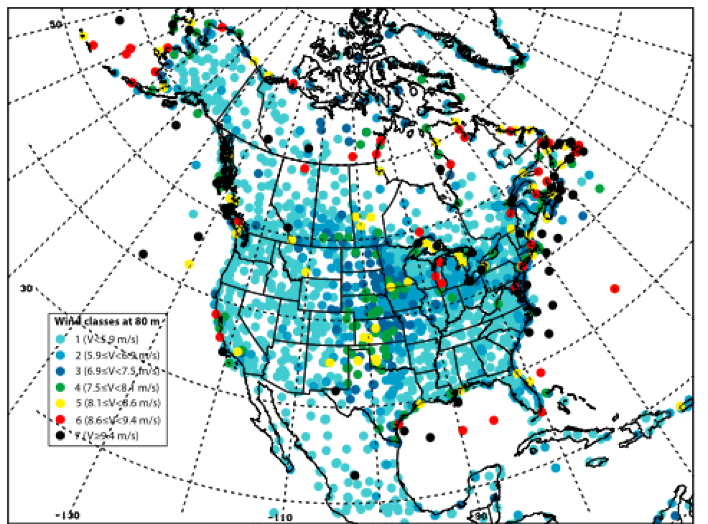A North American Wind Energy Scenario
Posted by Big Gav in electricity grid, wind power
I've got another guest post from Neil Howes up at TOD, this one proposing a rough plan for North AMerica to obtain 50% of its power from wind by 2030 - A North American Wind Energy Scenario.
Would a “50% of electricity generated by wind scenario” work in North America by 2030? In this post, I make a rough cut estimate of what might be required to make such a transition in about 20 years time.
Most proposals that are being made rely on a very big increase in carbon free energy, both to charge electric vehicles (EV’s) and to replace oil and natural gas (NG) presently used for hot water and space heating. In this post, I lay out a path by which 50% of North American energy might come from wind by 2030, including replacement of a large share of oil and natural gas use by electricity. ...
High quality wind resources (wind speeds greater than 6.9m/sec) in the US are estimated to be >5,500GWa, about x10 all of N America’s present electricity production of 550GWa. Canada’s potential appears to be similar or greater than the US, while Mexico’s wind resources are more limited (these figures do not include deep offshore resources that could be harnessed by floating wind turbines or higher altitude wind resources that could potentially be harnessed by airborne wind turbines).
For example, the Great Lakes have excellent offshore wind resources, and are close to major demand, with a potential of 321GWa in Michigan waters alone. Wind resources are widely distributed although some regions especially the SE of US, have poorer resources.
If an additional 372GWa was to be generated from wind power by 2030, this would require an expansion of today’s 26GW capacity to 1142 GWc. I am using a 0.33 capacity factor although this could well be higher as larger turbines are built and with expanded grid infrastructure, better remote wind sites will be developed including off-shore wind having a higher capacity factor. Such an expansion would require new capacity additions to rise from the 2008 level of 9GWc to 60GWc per year by 2013, and continue at that level until 2030.
This is more than the National Renewable Energy Lab's (NREL) 20% by 2030 wind power proposal that envisioned installing 16GW capacity per year, but the NREL expected much slower growth than has occurred, thus the US alone has reached 2013 expected capacity in 2008. Wind capacity would have to increase by 50% for 5 years to reach 60GW capacity additions per year by 2013, allowing an additional 1110GW capacity to be built by 2030. ...
Critical to any plan that involves a large expansion of renewable energy is the expansion of the N American grid with long distance HVDC connections between regions of high wind, solar and hydro electricity generation and regions of high electricity consumption. A 3,000 km UHDV link from Alaska and the Yukon to both the Western and Eastern Interconnections would be especially important to access both wind and hydro resources and would add extra stability to the grid. Losses by a 800,000V DC line would be 2% per 1,000km, less than existing 1,000km HVDC used today to bring power from Canada to the Eastern Interconnect. Good wind resources along the arctic coasts of Hudson Bay and Labrador would only need short transmission lines to connect with existing James Bay (QC), Nelson River (MAN) and Churchill Falls (NFL) hydro schemes, sharing the same HVDC lines to the eastern interconnect. A southern HVDC line from Arizona/Sonora solar power sites to Mexico City would also link into the Rocky Mountain and Mid-West wind regions.






